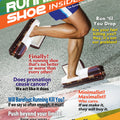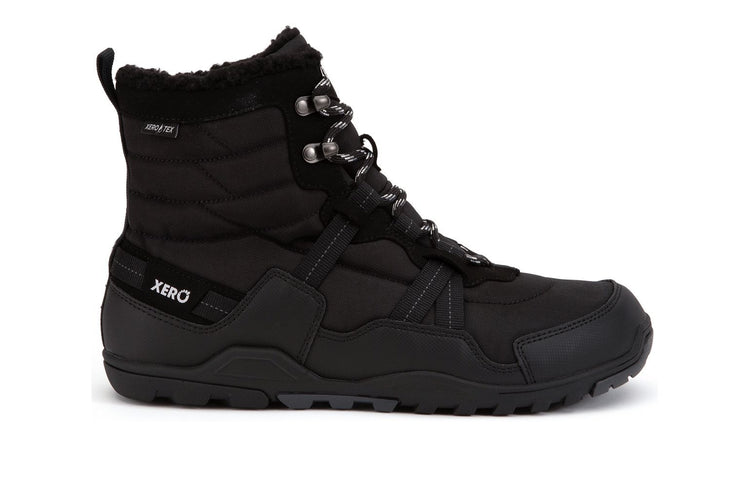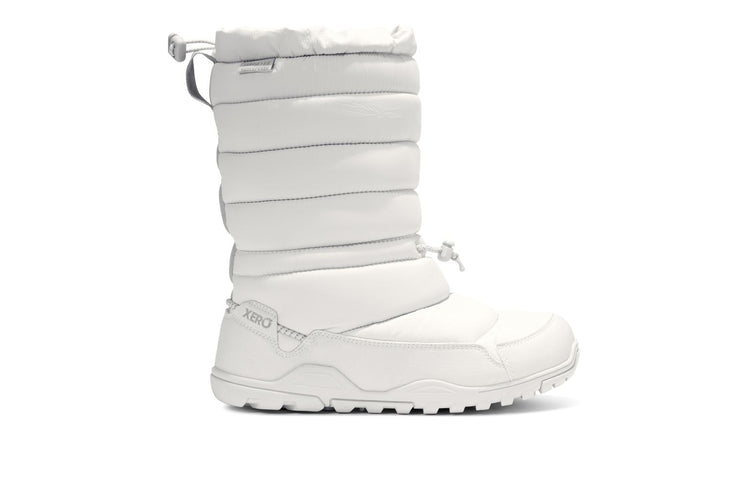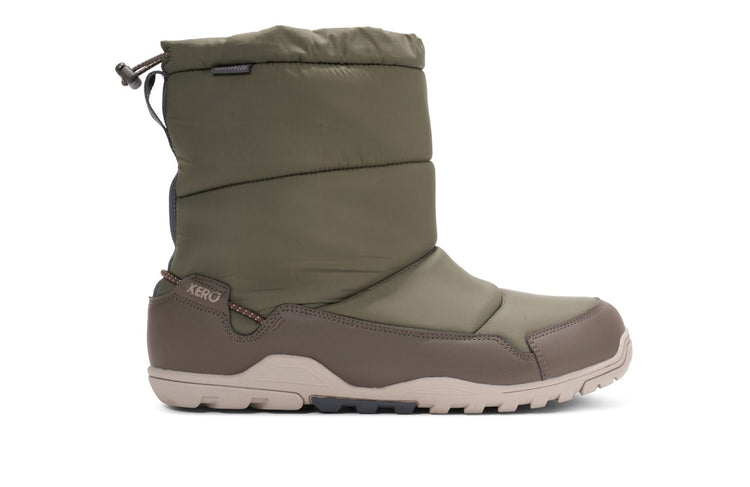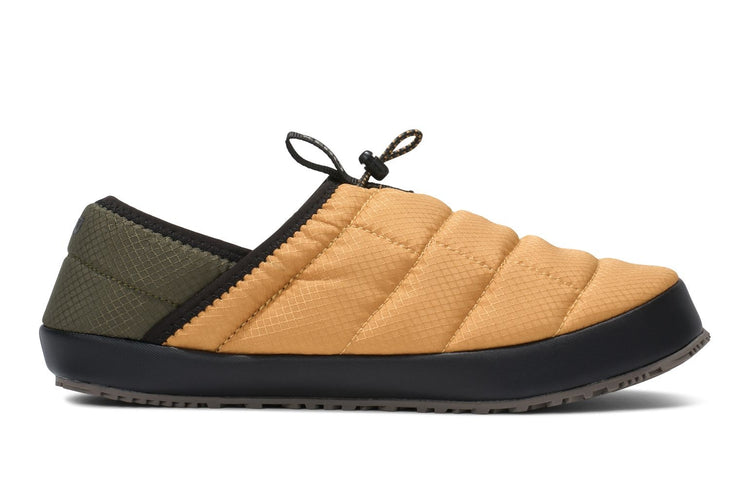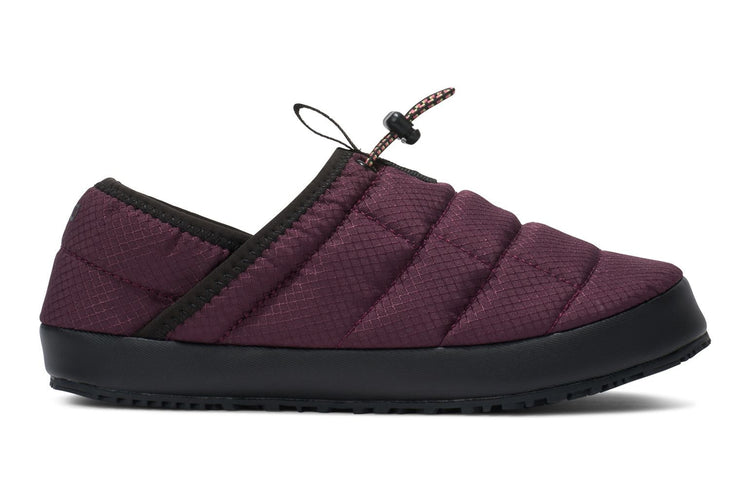latest News
Why Barefoot Running?
While barefoot running isn't new, it's popularity has been going through the roof since Christopher McDougall's book, Born To Run, became popular in 2009.Ironically, Born To Run isn't really about barefoot running. It's about the Tarahumara Indians in the Copper Canyon of Mexico and how they're able to run pain-free and injury free for hundreds of miles, well into their 70s. It's about the first ever ultramarathon held in the Copper Canyon. It's about the fascinating characters around this race. And it's about Chris's exploration of safer, more enjoyable running.By the way, if you haven't read the book, you must. It's a great, exciting read, whether you're a runner or not. And, admittedly, I make fun of the fact that barefoot runners treat this book like the bible in my video, Sh*t Barefoot Runners Say and the follow-up, Sh*t Runners Say To Barefoot Runners.It happens that around the time the book was becoming popular, one of the people featured in the book published a study about barefoot running. That person is Dr. Daniel Lieberman from Harvard University and, in a nutshell, what Daniel showed was: Runners in shoes tend to land on their heels, essentially using the padding built into the shoes Landing in this manner sends a massive jolt of force (called an impact transient force spike) through the ankles, knees, hips, and into the spine Then... Runners who run barefoot tend to land on their forefoot or midfoot, with the landing point nearer to the body's center of mass (not out in front of the body, like shod runners) Barefoot runners use the natural shock-absorbing, spring-like mechanism of the muscles, ligaments and tendons within and around the foot, the ankle, the knee, and the hip. Barefoot runners do not create the impact transient force spike through their joints In short, running shoes could be the cause of the very injuries for which they're sold as cures!Take off your shoes and you're less likely to land in a biomechanically compromised manner.This seems to explain why people who run barefoot often report the elimination of injuries (that were caused by bad form that they no longer use) and, more importantly, that running is more fun!Now it's not all as simple as this.The shoe companies, realizing that barefoot was becoming a big deal, began selling "barefoot shoes"... most of which are no more barefoot than a pair of stilts.Even the Vibram Fivefingers, which look like bare feet, aren't necessarily as barefoot as they appear.The key to successful barefoot running seems to be the ability to use the nerves in your feet, to Feel The World. Basically, if you try to run barefoot the same way you do when you're in shoes, IT HURTS!Figure out how to do what doesn't hurt and you'll be running in a way that's more fun and less likely to cause injuries.Now, I know it's not as simple as that, and I'm the first to admit that the science supporting barefoot running isn't in yet. But, then again, there's no science that shows that running shoes are helpful.Think about this: people lived for millions of years without shoes, or without anything more than a pair of sandals like Xero Shoes or a pair of moccasins. Runners ran successfully up until the 1970s with shoes that had no padding, no pronation control, no orthotics, and no high-tech materials.The three parts of our body that have the most nerve endings are our hands, our mouths and our feet. There's only one of those that we regularly cover and make numb to the world... does that seem right?Put a limb in a cast and it comes out of the cast a month later atrophied and weaker. When you bind your feet in shoes that don't let your foot flex or feel the earth, isn't that similar to putting it in a cast (or as barefoot runners like to say, a "foot coffin")?There's a lot more on this site about what the benefits of barefoot running -- and walking, and hiking, and dancing, and playing -- may be. If you have any questions, ask them here, or on our Forum. Or follow us on Facebook, Twitter, Youtube, and Pinterest.Join the conversation. Join the conversion. Feel The World!
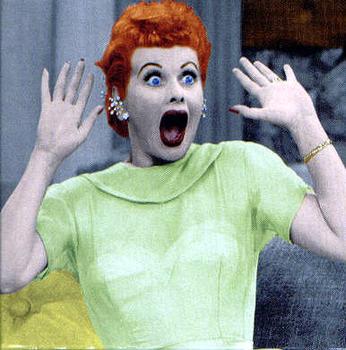
Bernard Lagat Won't Run Barefoot?
This just in from the "WHAT A SHOCK... NOT" category:Runner who gets paid millions from shoe company says he won't run barefoot!In an interview with The Guardian, Bernard Lagat, the Kenyan-American 13-time medal winning middle- and long-distance runner, is asked by Kate Carter:So, um, ever run barefoot?Bernard's response:[Laughs] Well, since I came to the developed world I’ve never run barefoot and I always say there’s no way on earth I am ever going to run barefoot. I did a good 15 years or so of barefoot running, walking. Now I see the shoes and I’m like, “That’s my best friend for life!” Never since I crossed the big pond! My shoes will always be on my feet for ever.Now let me see if I get this straight. A guy who gets paid millions from his shoe company sponsor will never go barefoot again.Let's say the guy really does simply love his shoes. Here's the question that Kate should have asked as a follow up:Bernard, do you think that 15 years of running barefoot helped you in some way, like improving your form and eliminating overstriding, or strengthening your feet and legs, or teaching you to adjust your gait and cadence, or improving your reflexes or sensorimotor skill? And please answer as if whatever you say will not be read by the shoe company that has helped make you a millionaire.Frankly, I couldn't care less what Bernard thinks or believes about running barefoot. The guy is one of the best middle- and long-distance runners ever. By definition that makes him a freak, an outlier.I'm not sure that a 5'8" guy who weighs 134 pounds and runs 1500 meters (just shy of a mile) in 3 minutes, 26 seconds, is someone whose experience extrapolates to normal humans.Be that as it may, what really gets to me is the headline:Bernard Lagat: 'There’s no way on earth I am ever going to run barefoot again!'Out of all the interesting and provocative and useful things Bernard said, I'm sort of dumbstruck why this became the headline. It's not like the world is FULL of barefoot runners who will be impacted by Bernard's thoughts. There aren't even a gaggle of runners on the fence about running barefoot who will see the headline and think, "Thank God I know Bernard won't run barefoot; now I don't have to either!"It's a headline that is only attention-grabbing to a small number of humans. So why all the fuss?I'm sure it had nothing to do with Bernard being sponsored by a shoe company that makes money every time some runners sees him in their shoes, and who is featured in the photograph at the top of the article (shown below so you know who it is).
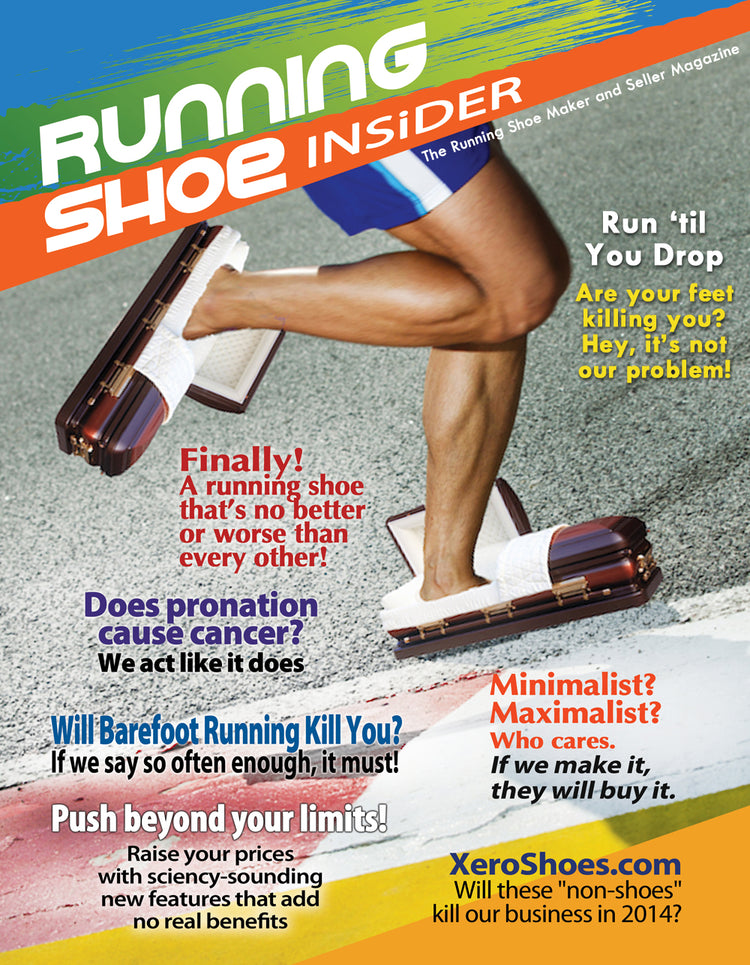
Running Shoes Insider Magazine - Secret edition!
After some sneaky social engineering, I got my hands on a copy of Running Shoe Insider, the magazine for running shoe makers and sellers.Up until now I had only suspected what they were really talking about behind closed doors. But now we know!Here's a photo of the cover.I'm sure you're as outraged and amazed as I am.Who knew that they actually KNOW they're making and selling foot coffins!?Pass this on to your friends, your family, the media!(And, I really hope you get that this is a joke ;-) )
Barefoot Running is Bad For You!
Is barefoot running good or bad for you? Despite the growing popularity of barefoot running, many people still believe the myth that barefoot running is bad for you. People who THINK barefoot running is bad for you will bring up certain assertions we will address below. If someone tries to convince you that barefoot running is bad for you, here’s how you can fight back against the common misconceptions! How We Got to This Point Over the years, the debate on whether barefoot shoes were bad for you has become more heated. It started when Chris McDoguall’s book, Born to Run, became popular In 2009... There was no big argument when Olympians Zola Budd ran barefoot In the 5,000m, or when Abebe Bikila won the marathon without shoes, or when Ron Hill competed in the Mexico City Olympics in “the lightest shoes I could find.” But once “regular folk” started kicking off their kicks, it’s become a rhetorical battlefield out there — the converts touting the great benefits of barefoot running, and the critics assuring everyone that taking off your running shoes is akin to playing Russian Roulette. Then a Harvard study came out, showing that when you run barefoot, you adjust your stride to put less stress on your body. But, right on the heels of it (pun intended), came editorials about how running barefoot is the worst thing you could do… though, most of those editorials came from people who own or work for shoe companies or shoe sellers. Yesterday, someone forwarded me an email saying “Well, I’ve seen people who tried running barefoot and they got injured! I’ve seen people during marathons, sitting on the side of the road in their barefoot shoes, crying in pain!” (Of course, right after, I got an email from a Xero Shoes huaraches running sandal owner, raving about how old running injuries they used to have are gone now that they’re out of shoes, but let’s ignore that for a moment.) Mark Plaatjes, world champion marathon runner, physical therapist, and co-owner of the Boulder Running Company, has said that he doesn’t think most people have the correct body type for running barefoot. Road Runner Sports sent out an email saying, “Well, if you run barefoot, you could step on something and really screw yourself up!” (that’s not the actual quote, which I’m too lazy to look up, but the gist of what they warned). The Vancouver Sun published an article, like dozens of others like it, claiming that running barefoot was dangerous, and the proof was the opinion of some doctors. What amazes me about this back and forth nonsense is how enraged the anti-barefoot gang is getting, and how they’ve thrown out not only their logic and critical thinking skills, but how they’ve ignored what every well-known barefoot running coach has advised. So let’s address some of the issues of barefoot running, as quickly as possible (which isn’t hard, since the arguments are simple). Why People Think Barefoot Running is Bad If you memorize these answers (or print out this article and have a copy in your back pocket), you can save yourself the frustration and/or humiliation of arguing with some Know-It-All who tries to convince you that running barefoot is bad. Assertion 1: Barefoot running will give you plantar fasciitis, Achilles tendonitis, ingrown hair, or male-pattern baldness (or any other injury). Response: Runners in SHOES get the same injuries! Those problems, when they occur, are not from “barefoot running”, they’re from OVERUSE or, more commonly, bad running form. If someone you knew went to the gym for the first time, and did the workout that Arnold Schwarzenegger used in his Mr. Olympia days, they’d end up with all manner of injuries, soreness and overall inability-to-move-for-days-ness. But nobody would scream from the rooftops, “Weight lifting is bad for you!” They would say to that individual, “Dude, you did too much too soon. Scale WAY back and build up to that slowly.” Clearly, the cure for overuse is UNDERuse. Do less. Build up slowly. Use some of the cues in these articles. The only problem is that the only way to know how much you can really handle is by doing too much… until you’ve done that enough and gotten the hint. Assertion 2: Some people aren’t built to go barefoot. Response: Not only is there no evidence for this, but what the barefoot running coaches all say is that by running barefoot you develop the skills, strength, and form that allow you to run barefoot. Now, there’s not any hard science behind that argument, YET(some researchers are working on it) But, which makes more sense: That someone is physically unable to run barefoot or in minimalist running shoes (the way humans have run for hundreds of thousands of years), but is absolutely fine in shoes… or that, due to lack of use, they may need to build up the strength before they can run barefoot. Besides, the only reason they would be okay in shoes and not barefoot, is because they’ve transferred the stress that the muscles and tendons and ligaments would have to deal with if they were barefooted (and get stronger by doing so) into the bones and joints.Again, the message is, Go slowly! (seeing a pattern here?) Assertion 3: You could step on something or, worse, IN something! Response: Yeah, so? But: How bad would it REALLY be?; How often is this REALLY a problem, or are you just imagining it happening without knowing the actual numbers?; Are these injuries worse than the various problems people have in shoes?; If you do step in poo… which is easier to hose off: your feet or a waffle-soled shoe? This argument cracks me up since I offer a solution on this website — get some barefoot running shoes or sandals and you’ll add a HUGE (but thin) layer of protection that still gives you a barefoot feel. I have to back up to the “stepping in poo” idea, because I just got a call from someone who said they were worried that’s what they would do if they were walking around barefoot. ”When’s the last time you stepped in poo?” I asked. “About 20 years ago,” the poo-fearer answered. ”Then what makes you think you’ll suddenly start doing it now?” I asked. “Ohh…,” said the former poo-fearer. Assertion 4: Doctors say they’re seeing more patients with injuries who are running barefoot. Response: Doctors said the same thing 45 years ago when running shoes became popular. Doctors are not seeing the people who are not having problems running barefoot… because those people don’t go to doctors. In other words, if you don’t know the total number of people who are running barefoot, seeing an uptick in patients is a meaningless statistic. I’ve never met a doctor who asked their injured patient, “So, are you running barefoot or in something like a barefoot shoe?” (hint, most people who say they’re running barefoot have never put their bare skin on the ground, or worn something as minimalist as Xero Shoes.). I’ve never met a doctor who has said to their patient, “Let’s take a look at some slow-motion video of you running and see if the real problem is your form, and not your footwear or lack thereof.” The injury rate for people wearing "normal" shoes is estimated at 50 to 80% per year. So the real question is this: are barefoot runners getting injured at a higher or lower rate? What cracks me up about the anti-barefoot gang is the simple denial of the numbers. That is, there are millions of people taking off their shoes without a problem. You don’t end up with a movement like the barefoot running movement without a high percentage of happy converts. This alone should, but doesn’t, temper their argument on why they think barefoot running is bad for you. And, again, the answer couldn’t be simpler: Oh, if you’re going to try barefoot running, you may need to go WAY slower than you thought. You’ll have to learn to listen to your body in a way you haven’t before, and you’ll need time to build up strength to let you handle the same distances you may now be running. You may also want to get something to give your sole a bit of protection. So, Barefoot Shoes Aren’t Bad for You?! Here are a few key differences between conventional running shoes and barefoot shoes. No heel lift (zero-drop) A wider, foot-shaped toe box to let your toes spread No unnecessary cushioning An extremely flexible sole that gives you protection but is thin enough to let the nerves in your feet safely FEEL the ground and be more connected to the earth, rather than walk on it. Discover what you've been missing – natural comfort, performance and health. Feel the fun and benefits barefoot inspired shoes and live life feet first The content of this post does not constitute and is not intended to be a substitute for professional medical advice, diagnosis or treatment. Always seek the advice of a physician or other qualified health provider with any questions or concerns you may have about your health or a medical condition.
find YOUR run
Do you know how many runners there are in the US? Take a guess. No…a little higher.There are approximately 49.4 million runners. That is roughly 1 out of 6 people. Runners of all kinds: casual runners, committed runners, weekend warriors, sprinters, 5k runners, marathoners, ultra runners and everything in between.If you haven’t noticed, as time goes on, races just become longer and longer and longer. Remember when the marathon used to be the ultimate distance running benchmark? Now you can run a 50 miler, the Leadville Trail 100 or the Badwater 135 mile race. Not enough? Try the self-proclaimed (and we agree) coldest and toughest race in the world – the Yukon Arctic Ultra. You can do up to 430 miles through snow and -50 degree temperatures. Still not enough? Line up for the Self-Transcendence 3100 mile race in Queens next June.We’re not saying these races are new, some of them have been around since the 1920’s, but they are newly popular. Ultrarunning is now glamorized and thanks to the famous Tarahumara in Born to Run and Marshall Ulrich’s feats in Running on Empty, the popularity will only increase.But what if you don’t want to run that far?Then don’t.Face the facts: you’re not Scott Jurek. You never will be. And that is OK. Really, it is. Scott didn’t get to where he was without a lot of hard work, training, and a LOT of running.Running 5 miles at a time isn’t for everyone – let alone 26.2. If you don’t enjoy it or don't have the available time to dedicate, then don’t do it! Our CEO Steven Sashen certainly doesn’t. He runs his distances in the shortest increments possible – as a Master’s All American sprinter for the 100 meter dash (and only a 60m dash during the indoor track season).There are 8,023 5K USATF Active Certified Road Courses and only 847 marathons, with a measly 93 ultras tacked on for good measure.For those of us that have run longer distances, if you do feel up to the challenge, seize the opportunity and register. Crossing the line after a marathon is a feeling that cannot be duplicated. But getting there requires a lot of training, patience and sacrifice. If you don’t have the interest or time, it’s not for you. In fact, if walking is all you want to do, go for it. Recent research from Kirk Erickson at the University of Pittsburgh shows that walking 6-9 miles per week keeps your brain from shrinking as you age.Whether it’s the local Turkey Trot or the Boston Marathon, the goal is to have FUN and be healthy. Do a distance that feels good and allows you to enjoy yourself. Be proud of getting yourself out the door and keeping the blood pumping. If you can, leave the Garmin at home. Use your run as an opportunity to pay attention to your body, absorb your surroundings and release stress. Lose yourself in the rhythm and cherish those moments while you are in them. Run for no other reason than the sheer pure joy of running.On that note…what is YOUR favorite distance or race to run?

